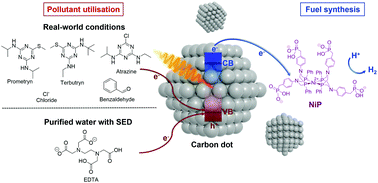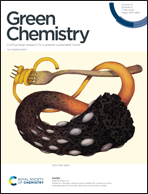Photocatalytic hydrogen generation coupled to pollutant utilisation using carbon dots produced from biomass†
Abstract
Photocatalysis is deemed as an appealing strategy to exploit solar energy for simultaneous fuel production and pollutant utilisation. However, current photocatalytic systems rarely couple both processes and commonly suffer from restricted scalability and sustainability as they use toxic or ultraviolet light harvesters, combined with noble-metal co-catalysts under corrosive conditions. Here, we show the synthesis of ultra-scalable and low-cost carbon nanodots from lignocellulosic waste, which when combined with a non-precious Ni-based co-catalyst, use visible light to drive H2 production in untreated river and sea water. Organic pollutants and chloride anions in these untreated media do not only allow unhindered photocatalytic activities, but also function as electron donors for the photoexcited carbon dots to enable proton reduction. This system combines Earth's most abundant resources (biomass, solar energy, untreated water) and functions at ambient temperature, pressure and benign pH, thereby creating perspectives for simultaneous fuel synthesis as well as sustainable and practical pollutant utilisation.



 Please wait while we load your content...
Please wait while we load your content...